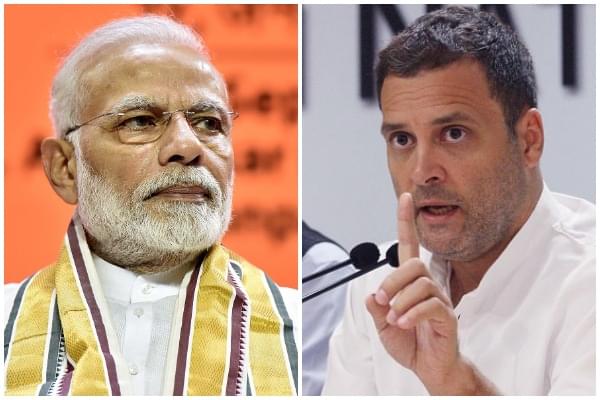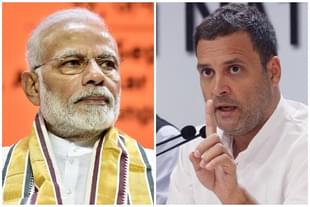Politics
It’s Now BJP Versus Congress In 2019, With Third Front Challenge Ruled Out
Amitabh Tiwari
Dec 15, 2018, 06:09 PM | Updated 06:09 PM IST
Save & read from anywhere!
Bookmark stories for easy access on any device or the Swarajya app.


The results of the five state assembly elections have been declared and the Congress has upstaged the Bharatiya Janata Party (BJP) in the Hindi heartland. The BJP’s longest-serving chief ministers, Raman Singh and Shivraj Singh Chouhan, had to face defeats. A variety of factors, including voter fatigue, local anti-incumbency, agriculture or rural distress, and growing urban apathy have been attributed to this defeat.
That the Congress managed to defeat the BJP in the Hindi heartland in a one-to-one contest without the help of any regional parties should come as a confidence booster for the party just before the finals in 2019. It also positions the Congress firmly as the number two party in the country. The road to 2019 has taken an interesting new turn and is likely to proceed to a close finish.
In Chhattisgarh, the BJP got routed, and contrary to expectations, Ajit Jogi hit the saffron party hard in the tribal belt. In Rajasthan, the BJP tested the trend like in 2008, as I have been saying for long. The Congress fell short of even getting a simple majority.
In Madhya Pradesh, even after 15 years of anti-incumbency – which is only natural – and agriculture distress, Shivraj Singh Chouhan was able to offer a tough fight to the Congress. In a cliffhanger contest, the Congress emerged as the single-largest party and will form the government soon with the help of Bahujan Samaj Party and independents.
In Mizoram, the Mizo National Front came back to power after 10 years, while the Telangana Rashtra Samithi (TRS) and K Chandrashekar Rao (KCR) painted the town pink in Telangana. The Mahakutumi (grand alliance) failed to make inroads, and the adage that alliances are not only about arithmetic but also chemistry turned out to be true once again.
Finalists For 2019 Identified After 2018 Assembly Semi-Finals
Somebody asked me why these elections are called “semi-finals”. It is because the semi-finals identify the two finalists. Before the elections, while it was clear that the BJP would be one of the finalists in the 2019 election decider, there was a question mark over the opponent – would it be the Congress or regional parties as part of the “Third Front”?
The results clearly identify the Congress as the other finalist in 2019. The grand old party’s victories means that the final match will play out between the Congress and the BJP. There are 180-odd Lok Sabha seats – one-third of total Parliament strength – where the battle is directly between the Congress and BJP. The latter currently holds more than 150 of these seats. The Congress will need to defeat the BJP in its den in these seats without any help from others to dislodge Modi from power in 2019.
A Victory Not Without Its Challenges
The triple wins for the Congress have come with many challenges. The party needs to be extra cautious because there is a short time frame of three months to keep the momentum going and milk these gains in the Lok Sabha. The biggest challenge for the party thus far has been choosing the chief ministerial face in the three states, between Sachin Pilot–Ashok Gehlot, Kamal Nath–Jyotiraditya Scindia–Digvijaya Singh, and T S Singh Deo–Bhupesh Baghel–Charan Das Mahant respectively. Everybody knows that all state units suffered from intense factionalism. But you can have only one chief minister and this may upset other tall leaders who may not work with the same zeal for the 2019 election.
Rahul Gandhi’s maturity will be put to test here. Also, the party has promised farm loan waivers to be implemented within 10 days of coming to power. We have seen in Punjab and Karnataka that the promises have not been fulfilled in its entirety, as it is a tricky matter. Chouhan in his press conference has already threatened to hit the roads if the Congress dilly dallies on its promise.
Currently, the BJP has 62 of the 65 Lok Sabha seats from the three states.
Road To 2019: Open, With No Clear Favourites
Generally, voting in state and national elections is done based on different factors. In Rajasthan, slogans like “Modi tujhse bair nahi, rani teri khair nahi (Modi, we don’t have a problem with you, but with Vasundhara Raje it’s a different matter)” were heard often on streets. So, theoretically, these results shouldn’t have a large impact on 2019 Lok Sabha election results.
However, the fact that the Lok Sabha election will be held in just three to four months from now brings in an interesting element in this analysis. History shows that whichever party has won in the Vidhan Sabha election in the state has gone on to win the most number of seats in the Lok Sabha election as well (see table). Going by this logic, the BJP could suffer a loss of about 30 seats on the basis of extrapolation.



There are, however, positives for both parties in these results. The contests in Rajasthan and Madhya Pradesh show that the BJP is not out of the picture in the state and the Congress has not been able to win hands-down. Chhattisgarh does show the Congress gaining significantly, but it’s a small state in the national context. There are chances of the TRS joining the NDA, which could provide an impetus to the BJP in the south, but here, again, the Congress and TDP could surprise pundits with their performance.
The wins ensure Rahul Gandhi passes the test of acceptability. From here on in, we could see him confidently negotiating with regional parties to form a grand alliance to take on Modi. However, for the Congress, merely highlighting the failures of the Modi government or non-fulfillment of its promises won’t help. It has to come up with tangible solutions instead of quick fixes like unemployment allowance and farm loan waivers.
The grand old party has to convince people why they should give it another shot even when it has not been able to solve the problems of the country over 55 years of rule. Modi has yet to come up with a narrative for 2019 and strategies need to be tweaked as the BJP is now in power and not the challenger.
Whether Modi will pull new tricks from under his sleeve or bank on his five years of government performance against the Congress’ 55 years of rule remains to be seen.
Amitabh Tiwari is a former corporate and investment banker who is now following his passion for politics and elections. Views expressed are personal. He tweets at @politicalbaaba.





